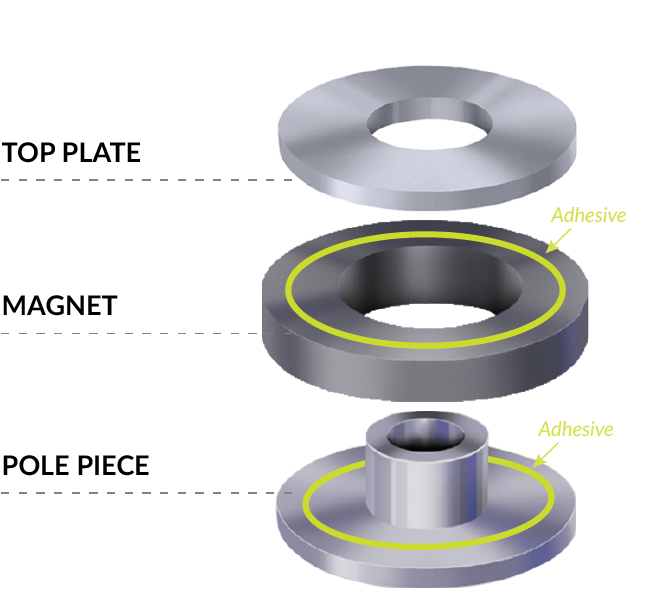The three essential components bonded in the magnet assembly are the magnet itself (most commonly ceramic ferrite rings) and either a T-yoke, which includes a pole piece, or a plate and pole combination, and a top plate, or washer, made of steel.
The T-yoke (referred to as the backplate, end plate, or pole and plate) is bonded onto one face of the magnet, and the top plate (referred to as the washer or front plate) is bonded to the other face.

Why should care about magnet bonding in Speaker Assembly?
The ferrite/ceramic magnets inside of speakers act as an electromagnet when an electric current is applied through a coil of wire. The magnet creates an opposing magnetic field that creates vibrations.
In other words, during the operation of the speaker, the bonding should be strong enough to resist the impact of the working environment. Otherwise, the endurance of speakers will not be reliable and eventually affect product quality.
Common issues in magnet bonding in Speaker Assembly
The most common reason why the bonding performance is not achieved is that mating surfaces are not clean enough. Steel parts may be contaminated with plating residues or lubricants, and the nature of the problem varies with the production process.
A by-product of the Blanchard grinding process that makes magnet faces smooth and parallel, is a coating of fine dust that should be cleaned from the mating surface before bonding, using a damp cloth. If any other residues are suspected, the mating surfaces of the parts should be cleaned with isopropyl alcohol or acetone. Otherwise, if using the chemical method is not effective, a physical one (such as Plasma Surface Treatment) should be involved.
What kinds of Adhesive/ Glue are recommended to use in Magnet Bonding in Speaker?
As we mentioned the impact and vibration resistant ability of adhesive is important, 2K Epoxy Adhesive was traditionally the favorite choice, especially in Asia, where the adhesive is widely known as “A/B glue”. However, a combination of poor or absent mixing techniques (running two beads over each other), and assembly line workers failing to rotate the parts while pressing them together, is a recipe for disaster. This approach requires that the operator dispense the correct ratio by eye, which may be difficult with components of differing viscosities. To optimize the assembly process, Epoxy has no longer ideal for this application.
Cyanoacrylates have been used for magnet and steel assembly in small and specialized drivers, and although they can be very fast, their long-term bond strength to ceramic materials remains questionable. The success of the method suggests that in low-stress applications, a rubber toughened cyanoacrylate may provide the desired performance. Occasionally, cyanoacrylates are used to tack parts together quickly, in combination with structural acrylics to insure the needed long-term durability.
Structural Acrylic Adhesive
Current thinking on the magnet to steel bonding runs in favor of structural acrylic adhesives, with several variations formulated for different surfaces, gap fill capability, and fixture times.
These structural adhesives are economical, fast, strong, easily dispensed, and create thin bond lines to minimize magnetic energy losses.
Our structural acrylics develop good handling strength in 15 to 30 seconds, which allows the magnet assembly to be magnetized within 5 minutes of assembly. This speed of fixture also allows the magnet assembly to be placed briefly into a clamp, where it can be pressed to create a very thin and uniform bonding. This extra step can be beneficial in high-performance drivers and compression drivers, where tolerances must be very tight.
Structural acrylics are used with primers, and the latest solventless primers for dichromate surfaces can bond to steel that has been dichromate, or plated with clear, black, or yellow zinc.
Ideally, the adhesive should not be applied over a painted surface, as the bond between the paint and the substrate can limit overall bond strength. Activators for acrylics or any other adhesives should be applied only onto the steel parts (at room temperature) so that the carrier solvents in the activator can evaporate entirely before assembly.
Since ceramic magnets are quite porous, the activator applied to them can wick deep below the surface. So while appearing to be dry on the surface and ready for bonding, the magnet may still be loaded with solvents. Trapped solvents may significantly slow the cure, and can weaken the ultimate bond strength.
For more information, please contact us through:





